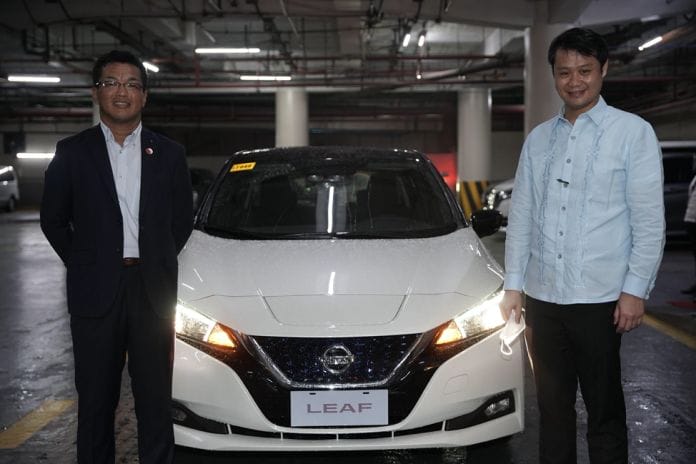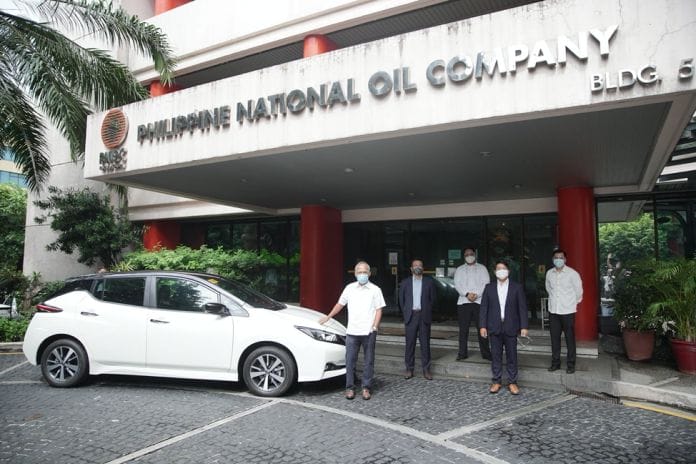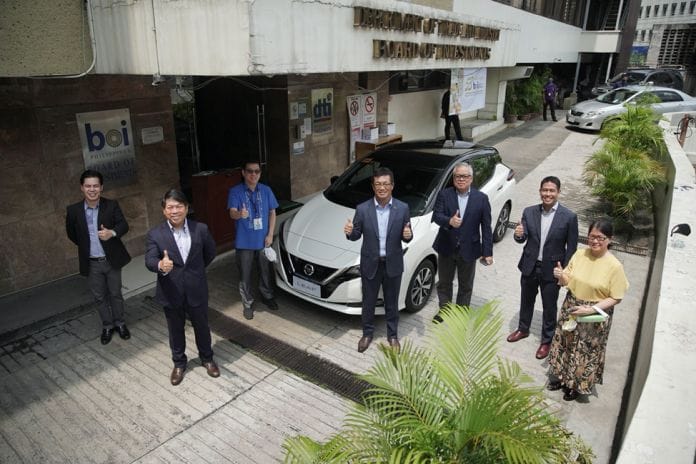With the current shift in the way Filipinos drive and live due to the COVID-19 pandemic, the need for safe, smart, and sustainable mobility solutions is greater than ever. At the recent annual Philippine Electric Vehicle Summit, Nissan continued to drive the conversation on electric vehicle (EV) adoption with educational information, as the brand prepares for the arrival of the Nissan LEAF in the Philippines.
As part of its educational efforts, the Japanese automaker also recently engaged key government policy-makers and industry leaders to be one of the first Filipinos to drive the Nissan LEAF on Metro Manila roads. Following strict health and safety protocols during the engagement, avid electrification supporters Senator Win Gatchalian, Energy Secretary Alfonso Cusi, Trade and Industry Secretary Ramon Lopez, as well as Electric Vehicle Association of the Philippines President Edmund Araga and Chairman Rommel Juan were able to experience firsthand driving the Nissan LEAF around Metro Manila.
With their experience, they learned more about the benefits of sustainable and electrified mobility with the vehicle to further strengthen the resolve towards adopting the use of electric vehicles for the country’s mobility needs.
“I think the Nissan LEAF is great. It has a great design, a smooth and comfortable drive, it’s economical, and most importantly, it is in line with our advocacy of pushing for electric vehicles towards energy security and sustainability,” shares Senator Win Gatchalian about the interesting features of the Nissan LEAF.

“The drive with the Nissan LEAF was effortless. E-vehicles like LEAF are also very beneficial to the environment with no noise and zero emissions. We have been waiting for electric vehicles to be part of the transportation mix,” says Energy Secretary Alfonso Cusi after experiencing the different features of the Nissan LEAF.

“With the Nissan LEAF, the drive was comfortable and very safe, indicative of how electric vehicles are the future of transportation. Given the impact of the pandemic on people’s health and the economy, we must rethink the way we do things and learn the importance of responsible consumption. The increase of electric vehicles on the road is one way things have changed because of the pandemic. This shows the power of consumers in helping our economy recover, as well as creating a greener and more sustainable post-COVID-19 future,” shares Trade and Industry Secretary Ramon Lopez after his drive with the vehicle.

Here are some key factors that Filipinos need to know about electric vehicles:
Range
The Nissan LEAF can cover 311 kilometers when fully charged. That’s the distance between Manila and Tagudin, Ilocos Sur. This allows drivers to easily travel to the NLEX Balintawak Toll Plaza (42 kms), Angeles City, Pampanga (85 kms), or San Juan, La Union (272 kms), and not have to worry about completely losing battery charge while on the road. In Manila, a single charge of the Nissan LEAF can last for about 3 weeks driving around the metro. For reference, the average driving distance around Metro Manila per day is only 13.2 km.
Charging
There are three primary ways to charge an EV, according to consumer preference and ease. Charging at home, usually overnight, with a standard universal cable can be done right away and takes 12 to 15 hours to fully charge the Nissan LEAF. This is the preferred method of charging because it is the most convenient. It is similar to charging in one’s mobile phone overnight after a long day of usage especially for everyday city driving.
A wall box can also be installed at home or in any establishment, and takes between five to seven hours. For on-road emergencies, a quick charging station can power up the Nissan LEAF in 40 to 60 minutes. There are currently 14 charging stations in the Philippines that can charge the Nissan LEAF, and more are being developed.
Environmental impact
EVs allow a reduction in noise pollution, a growing issue in urban centers. A Nissan LEAF has a running noise level of 21 decibels, compared to the average 76 decibels that a car produces when it is stationary.
Moreover, EVs produce zero direct emissions, which means they are a good choice for the environment. Just one electric vehicle can save 4.6 metric tons of greenhouse gases each year, roughly equivalent to planting 209 trees. With more than 470,000 Nissan LEAF vehicles already sold globally, their owners have saved 2.2 million metric tons of carbon dioxide—an amount which takes more than 84 million trees to process into breathable oxygen.
Trend
To support sustainable initiatives and reduction of emissions across Southeast Asia, Nissan has already introduced the Nissan LEAF to several Southeast Asian countries like Thailand, Malaysia, and Singapore. The Philippines will be among the next countries to join the electric mobility movement with the launch of the Nissan LEAF soon.
“At Nissan, we go beyond what is expected to dare the impossible. We lead the conversation around EV adoption in the Philippines to support a zero-emission future. Our aim is to make electrified mobility a reality as we adapt to the new normal, using the emission-free Nissan LEAF to give the Philippine market smarter, safer, and more sustainable mobility,” said President and Managing Director for Nissan in the Philippines Atsushi Najima.

